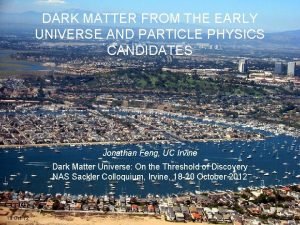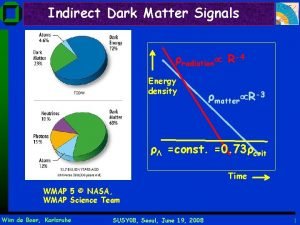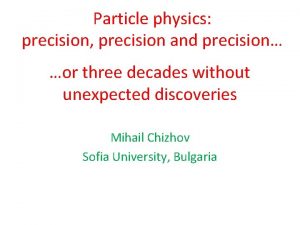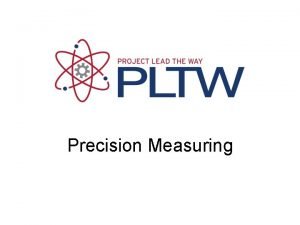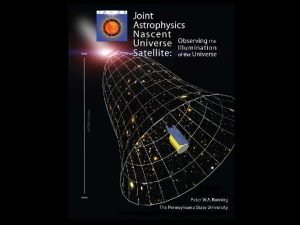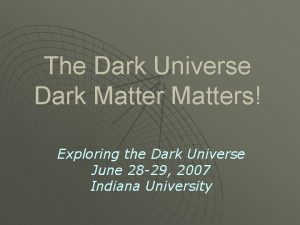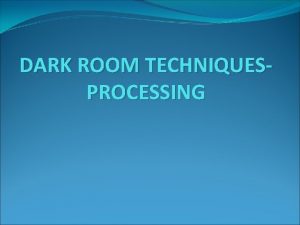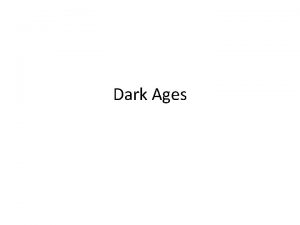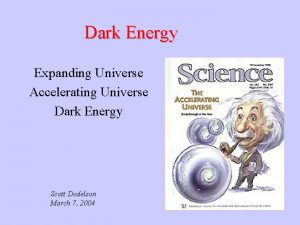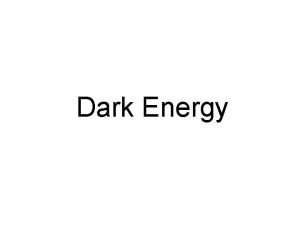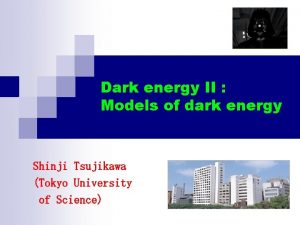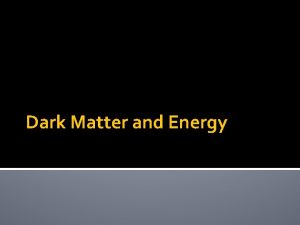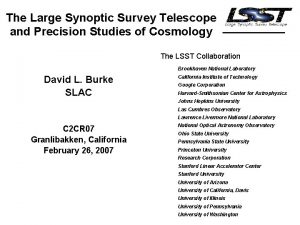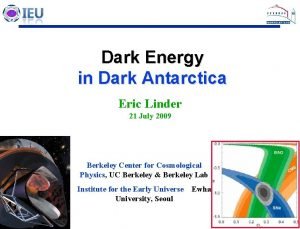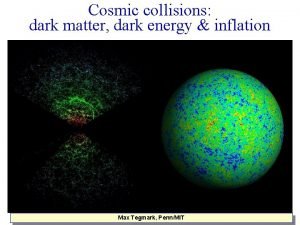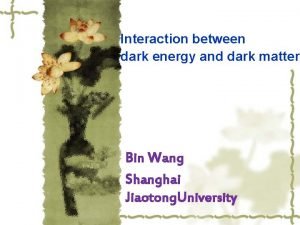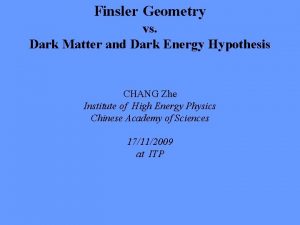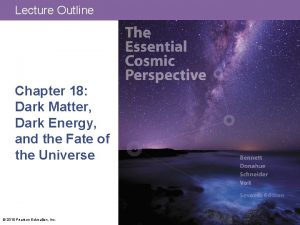Precision Studies of Dark Energy with the Large





























- Slides: 29

Precision Studies of Dark Energy with the Large Synoptic Survey Telescope David L. Burke SLAC for the LSST Collaboration Rencontres de Moriond Contents and Structures of the Universe

The LSST Collaboration Brookhaven National Laboratory Harvard-Smithsonian Center for Astrophysics Johns Hopkins University Las Cumbres Observatory Lawrence Livermore National Laboratory National Optical Astronomy Observatory Ohio State University Pennsylvania State University Research Corporation Stanford Linear Accelerator Center Stanford University of Arizona University of California, Davis University of Illinois University of Pennsylvania University of Washington

Outline • The LSST Mission • The LSST Telescope and Camera • Dark Energy Science • Schedule and Plans

The LSST Mission Photometric survey of half the sky ( 20, 000 square degrees). Multi-epoch data set with return to each point on the sky approximately every 3 nights for up to 10 years. Prompt alerts (within 60 seconds of detection) of transients to observing community. Fully open source and data. Deliverables Archive 3 billion galaxies with photometric redshifts to z = 3. Detect 250, 000 Type 1 a supernovae per year (with photo-z < 1).

LSST Performance Specifications Cadence of two 15 second exposures with 2 second read-out followed by 5 second slew (open-loop active optics) to new (nearby) pointing. FOV = 3. 5 degrees diameter. Single-exposure Depth = 24. 5 AB mag. (r-band) Stacked (300 -400 exposures) Depth = 27. 8 AB mag. (r-band) Median Image PSF (FWHM) = 0. 7 arc-sec. Broad-band (ugrizy; 350 nm-1050 nm) internal photometric accuracy of 0. 010 mag (zero-point across the sky). Relative astrometric accuracy of 10 mas. Fast, Wide, Deep, and Precise

Telescope and Camera 3. 4 m Secondary Meniscus Mirror 3. 5° Photometric Camera 8. 4 m Primary-Tertiary Monolithic Mirror

Telescope Optics PSF controlled over full FOV. Paul-Baker Three-Mirror Optics 8. 4 meter primary aperture. 3. 5° FOV with f/1. 23 beam and 0. 20” plate scale.

Similar Optical Mirrors and Systems Large Binocular Telescope f/1. 1 optics with two 8. 4 m primary mirrors. SOAR 4. 2 m meniscus primary mirror

Camera Filters and Shutter ~ 2 m Cryostat Focal Plane Array (at 153 K) Refractive Optics

Focal Plane Array (FPA) Pixels: 3. 2 109 on 10 mm pitch. Plate Scale: 0. 200 arc-sec. FPA Flatness: 10 mm peak-valley. “Raft” of nine 4 k 4 k CCDs 3. 5° Field of View (634 mm diameter) Shack-Hartmann Wavefront Sensors and Fast Guide Sensors

Survey Power

Multi-Epoch Data Archive Average down instrumental and atmospheric statistical variations. Large dataset allows systematic errors to be addressed by subdivision.

Multi-Epoch Data Archive Average down instrumental and atmospheric statistical variations. Large dataset allows systematic errors to be addressed by subdivision.

LSST Dark Energy Highlights o Weak lensing of galaxies to z = 3. Two and three-point shear correlations in linear and non-linear gravitational regimes. o Supernovae to z = 1. Discovery of lensed supernovae and measurement of time delays. o Galaxies and cluster number densities as function of z. Power spectra on very large scales k ~ 10 -3 h Mpc-1. o Baryon acoustic oscillations. Power spectra on scales k ~ 10 -1 h Mpc-1.

Disclosure and Agreement Unless stated otherwise, error forecasts are not marginalized over unspecified parameters. Generally, flat-space ΛCDM values are assumed for unspecified parameters. Do you accept the terms and conditions of this agreement? I accept. I do not accept.

Weak Lensing Geometry Sheared Image a = 4 GM/bc 2 q DLS DS Impact Parameter b Shear DLS g~q= 4 GM/bc 2 DS Cosmology changes geometric distance factors. Gravity & Cosmology change the growth rate of mass structure.

Shear Power Spectra Tomography Measure • Shear spatial auto-correlation binned in z. • Cross correlations between different bins in z. Differing sensitivities to cosmology and gravity. 0. 01 0. 001 Linear regime Needed Shear Sensitivity ΛCDM Non-linear regime LSST expects well below 0. 001 in residual shear error ….

Weak Lensing Through the Atmosphere Data from Prime-Cam on 8 -m Subaru Single 10 sec exposure in 0. 65 arcsec seeing. 13 arcmin (l = 40) Raw De-trailed <shear> = 0. 04 0. 07 PSF Corrected <shear> = 0. 000013 0. 000007 LSST Goal: Residual shear 0. 0001. Train on random half of the stars; measure residual shear on other half.

Residual 2 -Point Shear Correlations LSST multi-epoch survey provides sensitivity well below target signal. LCDM shear signal Typical separation of reference stars in LSST exposures.

Photometric Redshifts and Weak Lensing Contours of constant error in w and wa as functions of statistical and systematic photo-z errors. Ma, Huterer (2005) Need to know bias and resolution in z with good accuracy. LSST goal … zbias 0. 002 (1 + z) Z 0. 003 (1 + z) … will match systematic errors in cosmological parameters to statistical errors for z 3.

Photo-z Calibration Campaign Together with angular correlations • Transfer fields - 200, 000 galaxies with 12 -band photo-z redshifts. of galaxies, this training set • Calibrate 12 -band photo-z with subset of 20, 000 redshifts. enablesspectroscopic LSST 6 -band photo-z error calibration to better than required for LSST statistics limit Simulation of 12 -band Simulation of 6 -band precision cosmology photo-z calibration field photo-z distribution for at 26 AB mag. LSST dataset. z 0. 05 (1+z) z 0. 03 (1+z) Need to calibrate transfer photo-z to 10% accuracy to reach desired precision

Studies of Supernovae with LSST Supernovae Data Sets Survey cadence will detect 250, 000 supernovae per year (to z 0. 8), and provide photometry every three days in rotating colors (primarily r, i, and z). Simulated light curves from the LSST deep field survey. z = 0. 8 Nightly deep-field survey will detect and follow supernovae to z 1. 2. Simulated Hubble diagram from 30, 000 supernovae detected over three years of observing in the LSST deep-field survey. photo-z

Weak Lensing and SNe-Ia Forecasts JDEM SNe wa LSST WL Combined w Combination of distance measurements from SNe with parameters from weak lensing …. Complementary probes of cosmology and gravity. Principal component analysis [Huterer and Starkman (2003)] of expected sensitivity to dark energy equation of state.

Baryon Acoustic Oscillations (BAO) CMB BAO RS~140 Mpc Standard Ruler Two Dimensions on the Sky Angular Diameter Distances Three Dimensions in Space-Time Hubble Parameter Baryon-DM Gravitational Effects Mode Coupling Clustering In-Fall Velocity Dispersion along Line-of-Sight

BAO Power Spectra Two-dimensions on the sky. 3 billion galaxies. Combination yields accuracy < ~ 2 % on w 0.

Three-Dimensional BAO and Hubble Suppression of line-of-sight modes by photo-z errors. Pphoto-z(k, μ) = Pz(k, μ) Present error on H. Accuracy needed for LSST WL and SNe. May do better. We will see.

LSST Project Milestones and Schedule 2006 2007 Site Selection Construction Proposals (NSF and DOE). 2007 -2008 Complete Engineering and Design Long-Lead Procurements 2009 -2012 Construction and First Light 2013 Commissioning

LSST Site Selection – Two Proposals Final Selection – 14 April 2006 San Pedro Mártir Cerro Pachón

Summary • The LSST will be a significant step in survey capability. Optical throughput ~ 100 times that of any existing facility. • The LSST is designed to control systematic errors. We know how to make precise observations from the ground. We know how to accurately calibrate photo-z measurements. Multi-epoch with rapid return to each field on the sky – advantages likely not yet fully appreciated. • The LSST will enable multiple simultaneous studies of dark energy. Complementary measurements to address degeneracy and theoretical uncertainty in a single survey. • The LSST technology is ready.
 Dark matter and dark energy ppt
Dark matter and dark energy ppt Sine bar advantages and disadvantages
Sine bar advantages and disadvantages Difference between precision and semi precision attachments
Difference between precision and semi precision attachments Single precision vs double precision
Single precision vs double precision In a dark dark town
In a dark dark town Paradigm shift from women studies to gender studies
Paradigm shift from women studies to gender studies Low energy precision application
Low energy precision application Energy energy transfer and general energy analysis
Energy energy transfer and general energy analysis Energy energy transfer and general energy analysis
Energy energy transfer and general energy analysis Cube of stabilized dark energy
Cube of stabilized dark energy Dma dark energy
Dma dark energy Lsu center for energy studies
Lsu center for energy studies Hình ảnh bộ gõ cơ thể búng tay
Hình ảnh bộ gõ cơ thể búng tay Slidetodoc
Slidetodoc Bổ thể
Bổ thể Tỉ lệ cơ thể trẻ em
Tỉ lệ cơ thể trẻ em Voi kéo gỗ như thế nào
Voi kéo gỗ như thế nào Tư thế worm breton là gì
Tư thế worm breton là gì Chúa yêu trần thế alleluia
Chúa yêu trần thế alleluia Các môn thể thao bắt đầu bằng tiếng bóng
Các môn thể thao bắt đầu bằng tiếng bóng Thế nào là hệ số cao nhất
Thế nào là hệ số cao nhất Các châu lục và đại dương trên thế giới
Các châu lục và đại dương trên thế giới Công thức tính thế năng
Công thức tính thế năng Trời xanh đây là của chúng ta thể thơ
Trời xanh đây là của chúng ta thể thơ Cách giải mật thư tọa độ
Cách giải mật thư tọa độ 101012 bằng
101012 bằng độ dài liên kết
độ dài liên kết Các châu lục và đại dương trên thế giới
Các châu lục và đại dương trên thế giới Thể thơ truyền thống
Thể thơ truyền thống Quá trình desamine hóa có thể tạo ra
Quá trình desamine hóa có thể tạo ra









